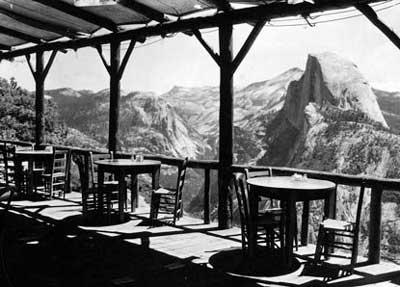A visit to Yosemite National Park in 2011 will certainly be a much different experience than a similar trip in decades past, and a new exhibit in the park will offer a wide-ranging and thought-provoking look at a Yosemite that's gone but perhaps not totally forgotten.
The early 1900s brought major changes that redefined both the park itself and the nature of a visit to Yosemite: the dramatic rise of automobile traffic; the construction of a train line to El Portal; the development of new roads and hotels; the increased popularity of camping, hiking and other outdoor pursuits; the establishment of the National Park Service; and an explosive growth in park visitation.
Those and other impacts on the park are explored in "Views & Visitors: the Yosemite Experience in the Early 20th Century." The exhibit begins on June 7 with a reception that's open to the public and will be on display through October at the Yosemite Museum, located in the Yosemite Village next to the Yosemite Valley Visitor Center.
The scope of the material included and the variety of media used to present it are impressive. According to a park spokesperson, "the exhibit will feature paintings, prints, artifacts, and ephemera from Yosemite from 1900 through 1946. Photographs and paintings of the landscape, early publications, memorabilia, and artifacts related to early visitor activities will be on view."
Included in the exhibit are some unusual items not usually on public display, including a 1912 Indian motorcycle (possibly the first to visit the park), one of the largest trout ever caught in Yosemite Valley, and a dogsled used in Yosemite Valley in the 1920s.
A digital slide show of historic photographs of Yosemite visitors and digitized film footage of early auto stages, train travel and visitor activities will complement the exhibit of artifacts. A listening station will allow visitors to hear oral histories related to early park visits as well as historic musical recordings.
Also included are early camp and hotel brochures, souvenirs and historic signs from this period and items related to the Yosemite Valley Railroad, Yosemite Winter Club, Indian Field Days and the opening of the Tioga Road.
Rounding out the exhibit will be fine art by Chiura Obata, Theodore Wores and Gunnar Widforss, along with works by photographers George Fiske, Arthur Pillsbury, Edward Weston and Ansel Adams.
The park’s collection will be supplemented for this exhibit by loans from DNC Parks & Resorts at Yosemite, Inc. and a number of private collectors.
The opening reception on June 7 will run from 5 to 7 p.m. and will include performances of historic songs by Tom Bopp, a Wawona historian and pianist. The exhibit will then be open from June 8 to September 30 from 9 to 5 daily, and from October 1 to 31 from 10 a.m. to 12 noon and 1 to 4 p.m. daily. This exhibit was made possible by a grant from The Yosemite Conservancy.
You'll find a map showing the location of the Yosemite Museum at this link, and information to help you plan a visit to Yosemite on the park website.




Add comment